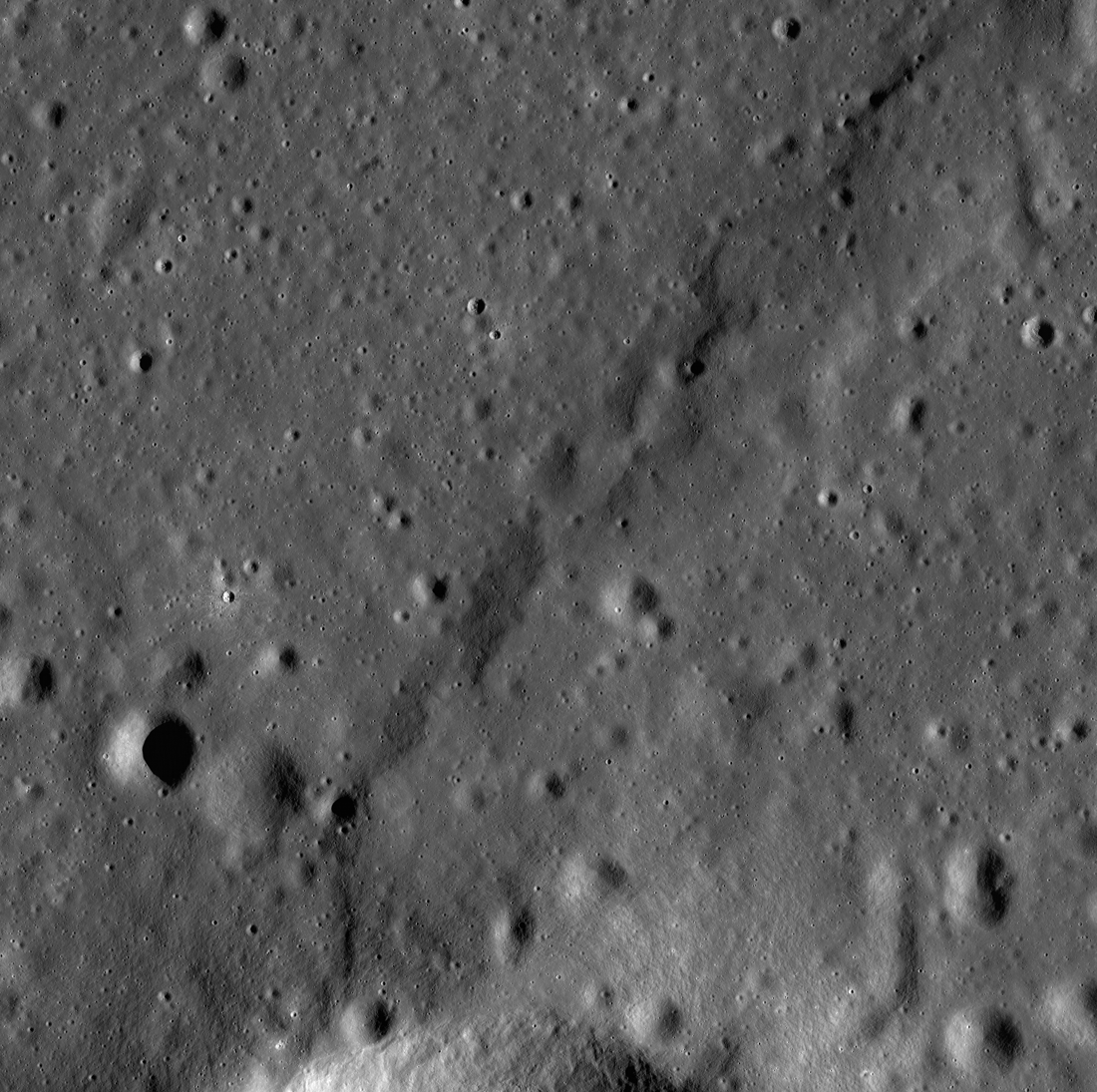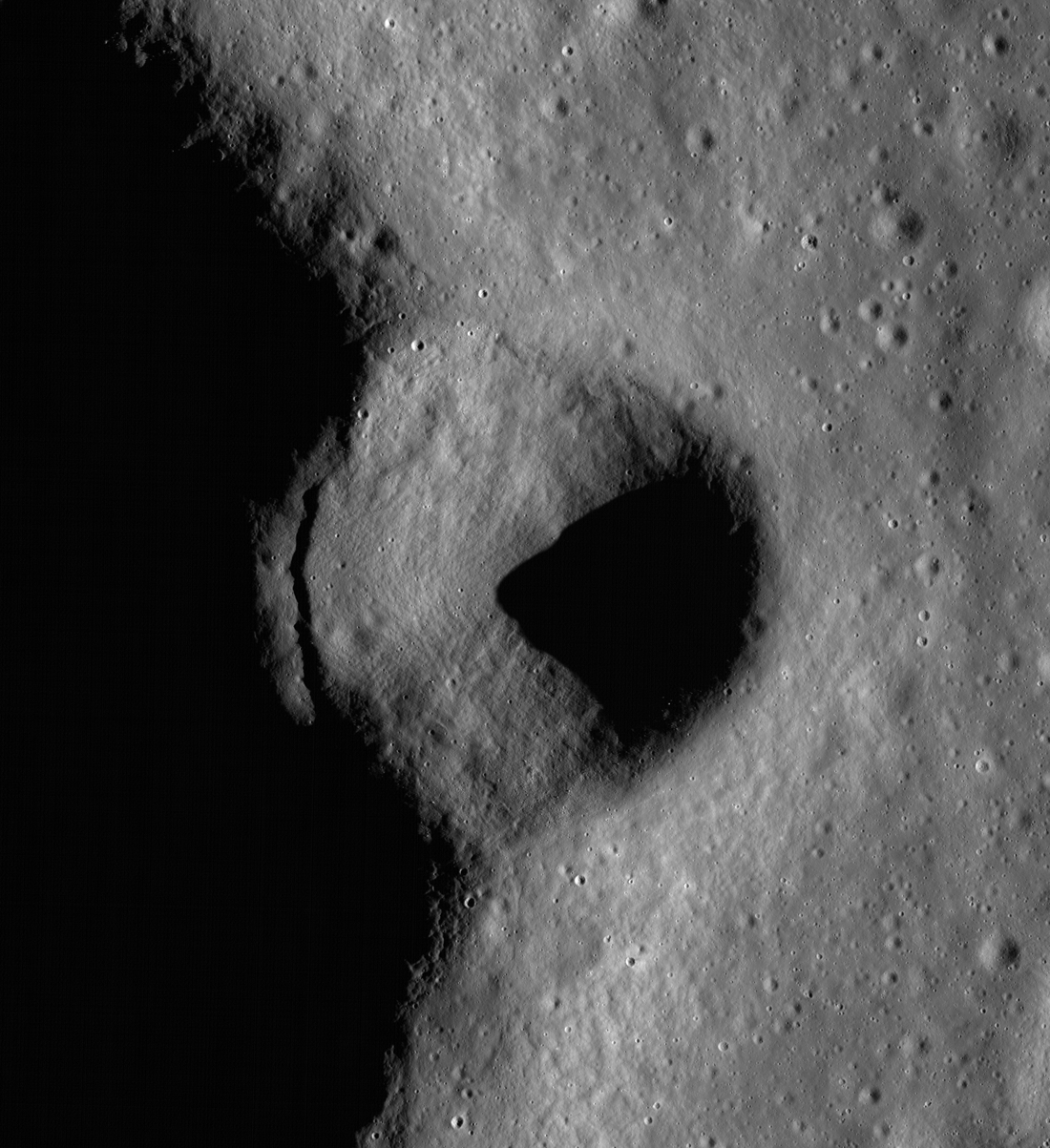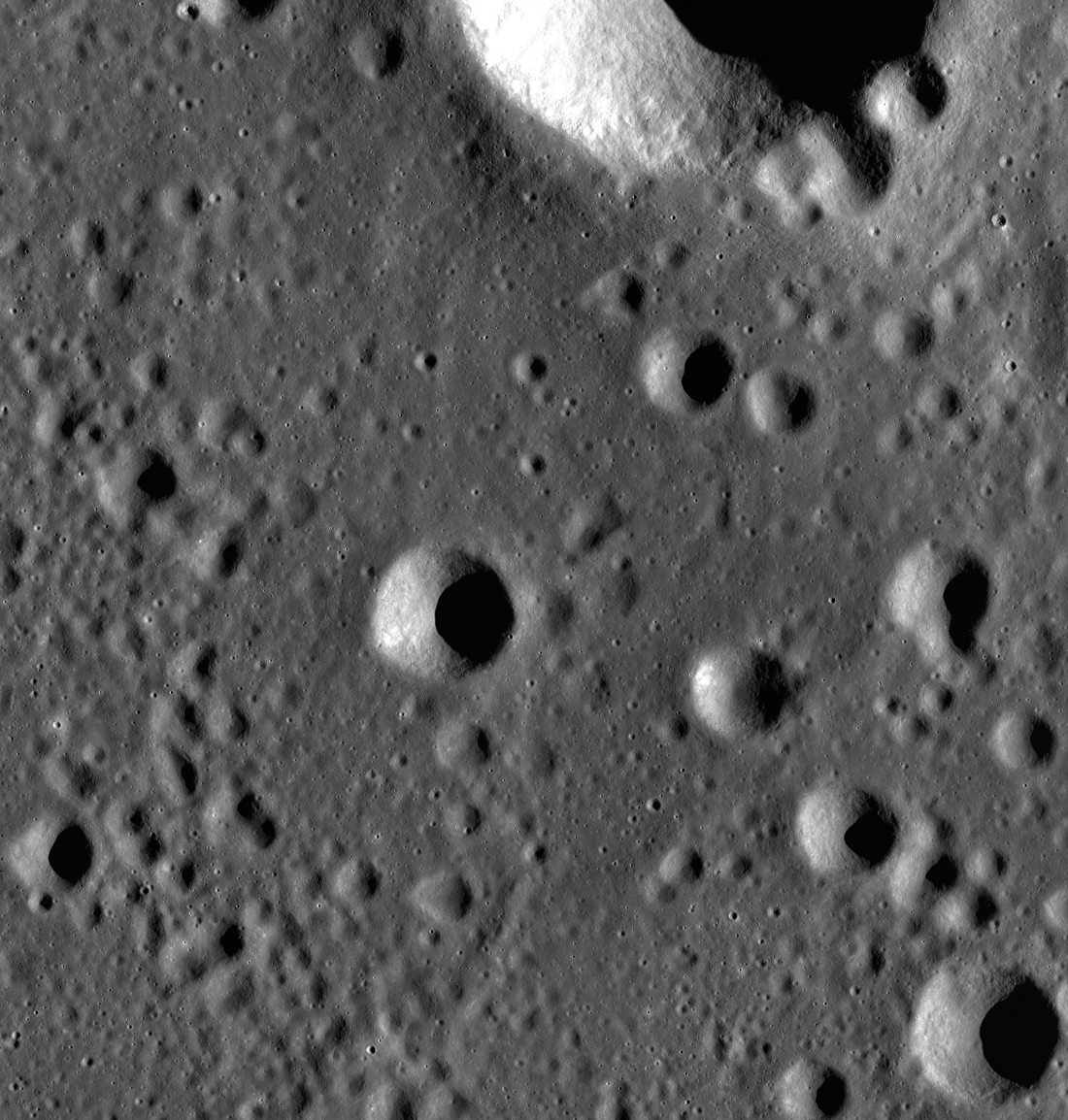
Blagg crater lies at the center of the Moon's nearside hemisphere (center lat 1.22° N, center lon 1.46° E) in Sinus Medii (Latin for "Central Bay"). Just five kilometers wide, Blagg crater stands out from the thousands of other Moon craters in its size class for two reasons: its neighborhood and its name.
The asteroid or comet that excavated Blagg crater happened to land squarely on a wrinkle ridge, a tectonic feature common on the Moon that is still not fully understood. The official term for wrinkle ridge is dorsum (Latin for "ridge"). They occur all over the lunar maria (Latin for "seas"), the mostly basalt plains that cover much of the nearside hemisphere.
Wrinkle ridges appear to be the surface expression of fractures in rock layers deep beneath the maria. The deep fractures in turn cause stresses and fractures in near-surface rock layers. The deep fractures typically show up as broad, low ridges in the maria that are hard to see. The near-surface fractures are much more obvious; enough so that they were first observed in the 1890s. They often appear as parallel and braided ridges atop the broad ridge.
Blagg crater could allow scientists to gain a better understanding of the interior structure of wrinkle ridges. It is a natural drill hole nearly a kilometer deep. When impacts produce craters, the deepest excavated material ends up on the crater rim. Scientists have used this principle of cratering mechanics to explore the lunar interior before — during Apollo 14 (31 January-9 February 1971), astronauts Alan Shepard and Ed Mitchell hiked nearly to the rim of Cone crater to sample deep layers of the Fra Mauro Formation, a vast blanket of ejecta draped over the Moon's surface by the giant Imbrium impact about four billion years ago.



If astronauts or a rover (or both) were someday to climb the Blagg crater rim to sample material from deep within the wrinkle ridge, they would probably avoid its east and southeast sides. Those parts of the Blagg crater rim have been battered and deformed by smaller impacts, which produced several unnamed craters. The largest of these is about a kilometer across.
Viewed from above, the rim craters appear round and level, but in reality they sag toward the center of Blagg crater. This is most dramatically displayed on the west side of the kilometer-wide crater. Look closely near the edge of the shadow that fills Blagg crater to see a 100-meter-high cliff formed when the kilometer-wide crater's west rim broke free and slumped.
The craters on Blagg crater's rim belong to a cluster of secondary craters trending toward the southeast. The Moon has no atmosphere and relatively low gravity, so ejecta blasted skyward by asteroid and comet impacts can travel for thousands of kilometers; in fact, some impacts are energetic enough to throw ejecta off the Moon entirely.
Ejecta often travels in swarms. Slow-moving ejecta tends to generate irregular pits and grooves when it strikes the surface, but fast-moving ejecta usually excavates a cluster of bowl-shaped craters. A cluster of secondary craters at Taurus-Littrow, the Apollo 17 landing site, is believed to have been excavated by an ejecta swarm thrown more than 2200 kilometers from its source at Tycho crater. No one is sure where the ejecta that excavated the secondary craters around Blagg crater originated.

Blagg crater is small as lunar craters go, but it is named for a giant in the history of Moon mapping. Mary Adela Blagg was born and lived nearly her entire life in the small town of Cheadle in central England. Born at a time when women rarely received education in math and science, she taught herself mathematics by borrowing her brother's textbooks. She became interested in astronomy when she was in her 40s after attending a series of public lectures. In 1905-1906, Blagg conducted painstakingly detailed observations of variable stars and published a mathematical analysis.
Her attention to detail led to a new project: the standardization of lunar feature names. The 19th century had seen publication of several highly detailed Moon maps, and it seemed that every mapper had his own feature-naming scheme. Professer S. A. Saunder, whose efforts to catalog the precise positions of specific Moon craters had been frustrated by more than a century of haphazard naming, invited Blagg in 1907 to help him bring order to chaos.
Saunder died in 1912, but Blagg continued their work, publishing the landmark Collated List of Lunar Formations in 1913. The publication established definitive names for nearly 5000 features on the Moon, but also pointed up the need for more work.
Between 1914 and 1918, the years of the First World War, Blagg continued her variable star observations and cared for children orphaned during the German invasion and occupation of Belgium. In January 1916, in recognition of her variable star studies and her lunar naming contributions, she became one of the first five women accepted as Fellows of the Royal Astronomical Society.
In 1919, astronomers formed the International Astronomical Union (IAU). Blagg became an early member of its lunar nomenclature group. Under IAU auspices, in 1935 she published with Czech amateur astronomer Karl Müller the two-volume Named Lunar Formations. It became the definitive guide to lunar nomenclature at least until the Moon missions of the 1950s, 1960s, and 1970s. Nomenclature guidelines Blagg established for the Moon influenced Solar System feature-naming practices still in use today.
You can explore the many intriguing details of Blagg crater by zooming in on the image below.
Sources
Yue, Z., Li, W., Di, K., Liu, Z., and Liu, J. (2015), Global mapping and analysis of wrinkle ridges, J. Geophys. Res. Planets, 120, 978-994.
Whitaker, E. A., Mapping and Naming the Moon: A History of Lunar Cartography and Nomenclature, New York: Cambridge University Press, 1999, pp. 154-165.
"Obituary Notices," Monthly Notices of the Royal Astronomical Society, Volume 105, Issue 2, 1 April 1945, pp 65-66.
Related Featured Images
Wrinkle Ridge in Mare Crisium
Wrinkle Ridge vs. Impact Crater
Bulging Wrinkle
Wrinkle Ridge Near Montes Teneriffe
Stress and Pull
Published by David Portree on 16 April 2019